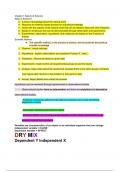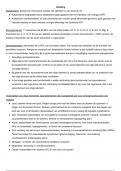Week 1: Introduction & Vulnerability: Environment and
Genetics
Historical and Cultural Perspectives on
Substance Use and Substance Use Disorders
PSYCHOACTIVE SUBSTANCE USE – HISTORY, PATTERNS, AND CULTURAL
VARIATION
Patterns of Substance Use
People engage in a variety of patterns of psychoactive substance use – which vary according
to:
(1) The type of substance
(2) The route of drug administration
(3) The frequency and quantity of use
Substance use is distinct from (1) problem use and (2) substance use disorders (SUDs)
- An understanding of patterns of substance use – provides a foundation for
understanding the compulsive and pathological substance use behaviors – that
characterize many of those with SUDs
Drug Classifications
Variety of natural – and synthetic – substances are psychoactive – in that they:
(1) Produce subjective feelings of intoxication – and/or reward
(2) Are self-administered
(3) Produce cognitive and behavioral changes in the user
No two drugs are identical – but many exert similar (1) physiological and (2) psychological
actions
There is no single – or ‘correct’ – classification system for psychoactive drugs – they can be
grouped based on:
(1) Their molecular structure
, (2) Clinical use
(3) Subjective effects
(4) Actions on neurotransmission
(5) Effects on the autonomic NS
(6) Effects on the CNS
Four General Classes of Drugs
Described are four very general classes of drugs – subject to abuse potential – including
- (1) narcotics, (2) general depressants, (3) stimulants, and (4) hallucinogens
The DSM-IV describes eleven drug classes in addition to an “other” category – including
alcohol, caffeine, amphetamines, cocaine, inhalants, nicotine, opiates, etc.
- This “other” category is important – because the number and types sof drugs is
NOT static
The Psychoactive Effects of Drugs
Drugs exert their psychoactive effects primarily in the central nervous system (CNS)
- But there are many different routes of administration – by which they are ingested
Routes of Administration
Some substances are primarily ingested via one particular route of administration – e.g.,
drinking alcohol
Many other substances – have multiple common routes of administration
(1) These can correspond with levels of substance involvement
- E.g., heroin can be snorted or injected – the latter route being associated with
greater potential for – and severity of – addiction
Different routes of administration – may involve different chemical preparations of a
substance
- E.g., smoking cocaine vs smoking crack
Routes vary with regard to – the speed of drug absorption into the brain
, - Which appears to be associated degree of (1) subjective high and (2) potential for
addiction
The fastest absorption – into brain tissues – occurs via the lungs
- Whereas absorption is relatively slow – for substances that are absorbed into the
bloodstream from the stomach and small intestine
Route of drug administration – may have social meaning
Example:
- Many of those who snort cocaine – have negative opinions on smoking crack
- Upper-class opium smokers’ use not considered a large social problem – but
lower-class opium smokers were
Substance Users
Substance users – differ in terms of the topography of use – which includes the dimensions of
(1) frequency and (2) quantity
Frequency of Use
The frequency of use of a substance – can range from one lifetime use – to use that occurs
daily or multiple times a day
- The frequency level – that is considered problematic by professionals – and the
public – varies according to (1) culture and (2) the substance in question
In Western societies – the daily use of small to moderate amounts of alcohol is NOT seen as
problematic
- Whereas many in these same cultures – would see monthly cocaine – or any
heroin – use as problematic and dangerous
Quantity of Use
The quantity – refers to the amount of a substance that is used during a (1) use episode or (2)
during a day in which use occurred
Quantity can be more easily measured for some drugs than for others:
, (1) Alcohol consumption – can be assessed using a measurable unit called a “standard
drink”
- The definition of this unit – varies by country and across research study
- The definition of this unit – requires knowledge of the alcohol content of various
beverages
(2) Psychoactive prescription drugs – are produced under laboratory standards of purity
and strength
- Quantity can be accurately measured
(3) Cocaine and marijuana – vary widely in their concentration and purity
- Making the number of puffs, joints, lines, etc. – a much cruder measure of actual
drug quantity
The quantity levels – at which substance use is considered problematic:
- Varies by culture
- Depends on the perceived risk of harm – of the drug in question
Overall
Reports of frequency and quantity – are often combined – to provide overall estimates of
substance use
- Such as the number of standard drinks – consumed in a week or a month
Patterns of use – are vary important above and beyond overall “Q/F” estimates
- E.g., consuming one drink per day has very different consequences than
consuming seven drinks once per week
Simultaneous Polydrug Use (SPU)
Many persons use two – or more – psychoactive substances in combination – i.e., at the same
time or in temporal proximity
- A phenomenon known as simultaneous polydrug use (SPU)
Some drug combinations – are known to produce novel psychoactive metabolites – that may
produce different effects than their precursor drugs
Example: The production of the metabolite cocaethylene – from combined alcohol and
cocaine use
Genetics
Historical and Cultural Perspectives on
Substance Use and Substance Use Disorders
PSYCHOACTIVE SUBSTANCE USE – HISTORY, PATTERNS, AND CULTURAL
VARIATION
Patterns of Substance Use
People engage in a variety of patterns of psychoactive substance use – which vary according
to:
(1) The type of substance
(2) The route of drug administration
(3) The frequency and quantity of use
Substance use is distinct from (1) problem use and (2) substance use disorders (SUDs)
- An understanding of patterns of substance use – provides a foundation for
understanding the compulsive and pathological substance use behaviors – that
characterize many of those with SUDs
Drug Classifications
Variety of natural – and synthetic – substances are psychoactive – in that they:
(1) Produce subjective feelings of intoxication – and/or reward
(2) Are self-administered
(3) Produce cognitive and behavioral changes in the user
No two drugs are identical – but many exert similar (1) physiological and (2) psychological
actions
There is no single – or ‘correct’ – classification system for psychoactive drugs – they can be
grouped based on:
(1) Their molecular structure
, (2) Clinical use
(3) Subjective effects
(4) Actions on neurotransmission
(5) Effects on the autonomic NS
(6) Effects on the CNS
Four General Classes of Drugs
Described are four very general classes of drugs – subject to abuse potential – including
- (1) narcotics, (2) general depressants, (3) stimulants, and (4) hallucinogens
The DSM-IV describes eleven drug classes in addition to an “other” category – including
alcohol, caffeine, amphetamines, cocaine, inhalants, nicotine, opiates, etc.
- This “other” category is important – because the number and types sof drugs is
NOT static
The Psychoactive Effects of Drugs
Drugs exert their psychoactive effects primarily in the central nervous system (CNS)
- But there are many different routes of administration – by which they are ingested
Routes of Administration
Some substances are primarily ingested via one particular route of administration – e.g.,
drinking alcohol
Many other substances – have multiple common routes of administration
(1) These can correspond with levels of substance involvement
- E.g., heroin can be snorted or injected – the latter route being associated with
greater potential for – and severity of – addiction
Different routes of administration – may involve different chemical preparations of a
substance
- E.g., smoking cocaine vs smoking crack
Routes vary with regard to – the speed of drug absorption into the brain
, - Which appears to be associated degree of (1) subjective high and (2) potential for
addiction
The fastest absorption – into brain tissues – occurs via the lungs
- Whereas absorption is relatively slow – for substances that are absorbed into the
bloodstream from the stomach and small intestine
Route of drug administration – may have social meaning
Example:
- Many of those who snort cocaine – have negative opinions on smoking crack
- Upper-class opium smokers’ use not considered a large social problem – but
lower-class opium smokers were
Substance Users
Substance users – differ in terms of the topography of use – which includes the dimensions of
(1) frequency and (2) quantity
Frequency of Use
The frequency of use of a substance – can range from one lifetime use – to use that occurs
daily or multiple times a day
- The frequency level – that is considered problematic by professionals – and the
public – varies according to (1) culture and (2) the substance in question
In Western societies – the daily use of small to moderate amounts of alcohol is NOT seen as
problematic
- Whereas many in these same cultures – would see monthly cocaine – or any
heroin – use as problematic and dangerous
Quantity of Use
The quantity – refers to the amount of a substance that is used during a (1) use episode or (2)
during a day in which use occurred
Quantity can be more easily measured for some drugs than for others:
, (1) Alcohol consumption – can be assessed using a measurable unit called a “standard
drink”
- The definition of this unit – varies by country and across research study
- The definition of this unit – requires knowledge of the alcohol content of various
beverages
(2) Psychoactive prescription drugs – are produced under laboratory standards of purity
and strength
- Quantity can be accurately measured
(3) Cocaine and marijuana – vary widely in their concentration and purity
- Making the number of puffs, joints, lines, etc. – a much cruder measure of actual
drug quantity
The quantity levels – at which substance use is considered problematic:
- Varies by culture
- Depends on the perceived risk of harm – of the drug in question
Overall
Reports of frequency and quantity – are often combined – to provide overall estimates of
substance use
- Such as the number of standard drinks – consumed in a week or a month
Patterns of use – are vary important above and beyond overall “Q/F” estimates
- E.g., consuming one drink per day has very different consequences than
consuming seven drinks once per week
Simultaneous Polydrug Use (SPU)
Many persons use two – or more – psychoactive substances in combination – i.e., at the same
time or in temporal proximity
- A phenomenon known as simultaneous polydrug use (SPU)
Some drug combinations – are known to produce novel psychoactive metabolites – that may
produce different effects than their precursor drugs
Example: The production of the metabolite cocaethylene – from combined alcohol and
cocaine use










